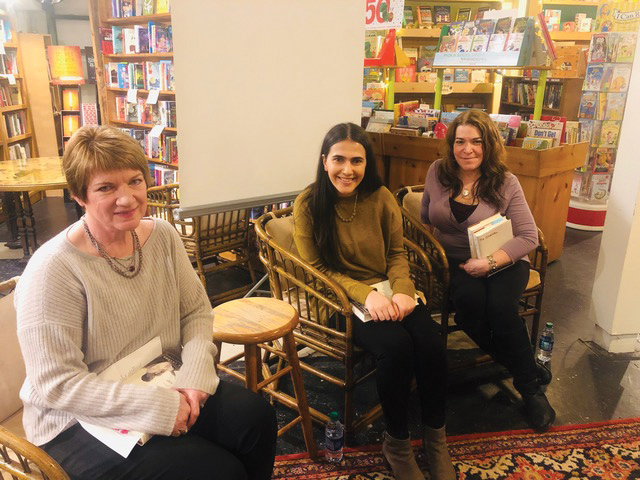Author reads letters to and from Obama, talks impact as first black American president
Amar Shabeeb/The Daily Northwestern
Jeanie Marie Laskas, Noor Abdelfattah and Tracy LaRock smile at Bookends & Beginnings. Laskas read from her new book “To Obama: With Love, Joy, Anger and Hope.”
February 21, 2019
In her book, “To Obama: With Love, Joy, Anger and Hope,” Jeanne Marie Laskas compiled letters between President Barack Obama and the American people. Laskas and two local letter writers joined Evanston and Chicagoland residents Wednesday for a reading of her new book.
Every day during his presidency, Barack Obama would read and respond to letters from 10 American citizens. The book features over 100 of these letters, and Laskas spent time in the mailroom, interviewed Obama and visited the letter writers to track their political influence in the White House. Laskas, joined by Noor Abdelfattah and Tracy LaRock, spoke to an intimate crowd at Bookends & Beginnings.
Nina Barrett (Medill, ‘87), owner of Bookends & Beginnings, introduced the three speakers and reflected on Obama’s presidency.
“Take out your hankies because you’re going to be weeping when thinking back to a time when the leader of our country genuinely cared about what individual citizens thought,” Barrett said.
Laskas said Obama received an average of 10,000 letters a day during his presidency, and he used the letters as a way to connect to the American people in a way that no president had ever done before.
“Who writes to the President? That’s like writing to Santa Claus,” Laskas said with a laugh.
Abdelfattah said her letter to Obama began as a rant. After hearing Donald Trump’s statements about Muslims in March 2016, the Muslim-American sent her thoughts to Obama.
In her letter, Abdelfattah described her family’s struggles in the United States — she wrote about her father’s long hours at low-paying jobs to keep her family afloat. She told the president how her brother survived being shot in the face when he was seven years old in a gang fight in her hometown of Chicago.
Abdelfattah said she wanted to thank Obama for his stance against Islamophobia, adding that his acceptance allowed Muslims like her family to continue to strive toward the American Dream.
Laskas said letters were a way for Obama to hear American citizens’ experiences, shape his policies and ensure that the American people had a voice. She described another letter from a 21-year-old woman about how her father dealt with unresolved Post Traumatic Stress Disorder as a veteran and attempted suicide. The letter resonated deeply with Obama and led him to pass the Clay Hunt Suicide Prevention for American Veterans Act to assist veterans in similar mental-health challenges, Laskas said.
In her letter to Obama, LaRock said in her work as a home health nurse, she often saw framed photos of the former president in the homes of her black patients. After Trump’s election, LaRock felt the need to emphasize the impact Obama had on the American people as the first black president. The Evanston resident thanked him for being the “beacon of hope” for the American people.
“Racism is like a chronic illness our country has,” LaRock said.
Laskas emphasized that the book’s purpose is not to idealize Obama, but rather to showcase the impact the letters had on the president, his aides and the writers themselves.
Laskas said her work showcases the trends of public opinion during Obama’s two terms, on topics ranging from the economic recession to LGBTQ rights.
“I embedded myself into the mailroom to show this hidden world of Obama’s administration,” Laskas said. “I wanted to document history and what Americans were thinking during this time through these letters.”
Email: [email protected]


